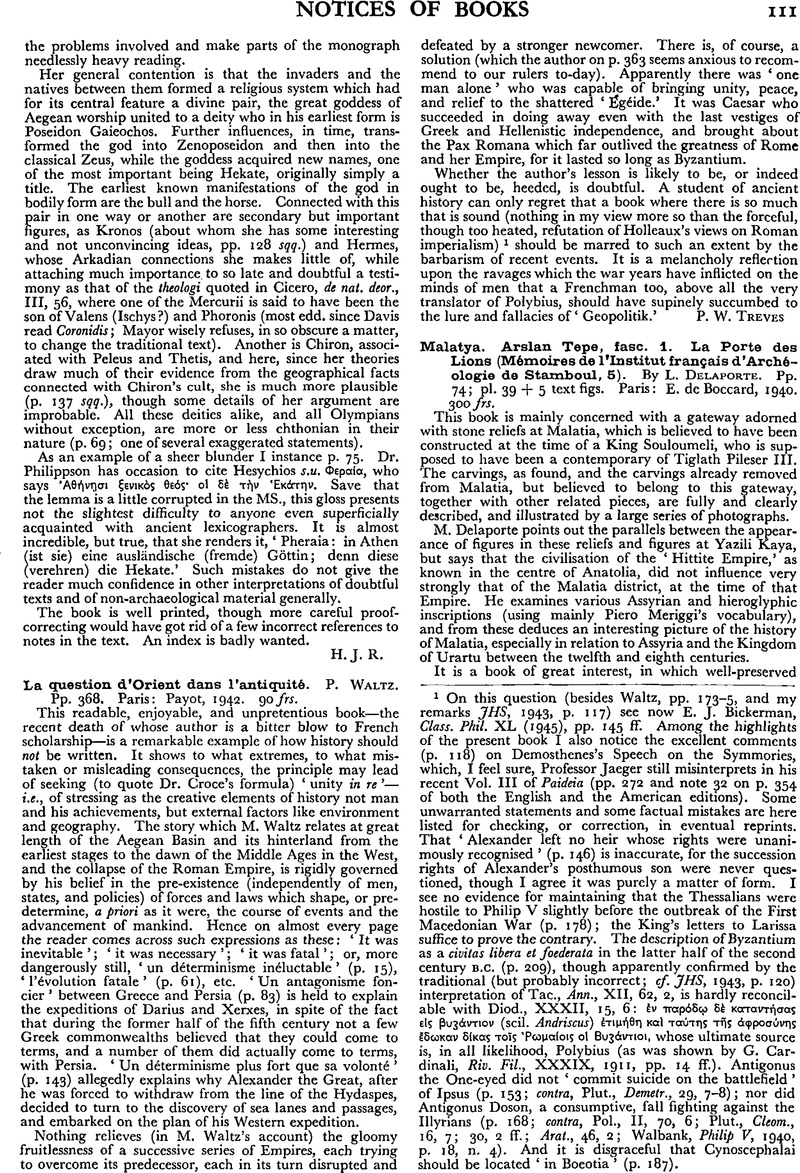No CrossRef data available.
Published online by Cambridge University Press: 23 December 2013

page 111 note 1 On this question (besides Waltz, pp. 173–5, and my remarks JHS, 1943, p. 117Google Scholar) see now Bickerman, E. J., Class. Phil. XL (1945), pp. 145 ff.Google Scholar Among the highlights of the present book I also notice the excellent comments (p. 118) on Demosthenes's Speech on the Symmories, which, I feel sure, Professor Jaeger still misinterprets in his recent Vol. III of Paideia (pp. 272 and note 32 on p. 354 of both the English and the American editions). Some unwarranted statements and some factual mistakes are here listed for checking, or correction, in eventual reprints. That ‘Alexander left no heir whose rights were unanimously recognised’ (p. 146) is inaccurate, for the succession rights of Alexander's posthumous son were never questioned, though I agree it was purely a matter of form. I see no evidence for maintaining that the Thessalians were hostile to Philip V slightly before the outbreak of the First Macedonian War (p. 178); the King's letters to Larissa suffice to prove the contrary. The description of Byzantium as a civitas libera et foederata in the latter half of the second century B.C. (p. 209), though apparently confirmed by the traditional (but probably incorrect; cf. JHS, 1943, p. 120Google Scholar) interpretation of Tac, Ann., XII, 62, 2, is hardly reconcilable with Diod., XXXII, 15, 6: ![]()
![]() (scil. Andriscus)
(scil. Andriscus) ![]()
![]() , whose ultimate source is, in all likelihood, Polybius (as was shown by Cardinali, G., Riv. Fil., XXXIX, 1911, pp. 14 ff.Google Scholar). Antigonus the One-eyed did not ‘commit suicide on the battlefield’ of Ipsus (p. 153; contra, Plut., , Demetr., 29, 7–8Google Scholar); nor did Antigonus Doson, a consumptive, fall fighting against the Illyrians (p. 168; contra, Pol., II, 70, 6; Plut., , Cleom., 16, 7Google Scholar; 30, 2 ff.; Arat., 46, 2; Walbank, , Philip V, 1940, p. 18, n. 4Google Scholar). And it is disgraceful that Cynoscephalai should be located ‘in Boeotia’ (p. 187).
, whose ultimate source is, in all likelihood, Polybius (as was shown by Cardinali, G., Riv. Fil., XXXIX, 1911, pp. 14 ff.Google Scholar). Antigonus the One-eyed did not ‘commit suicide on the battlefield’ of Ipsus (p. 153; contra, Plut., , Demetr., 29, 7–8Google Scholar); nor did Antigonus Doson, a consumptive, fall fighting against the Illyrians (p. 168; contra, Pol., II, 70, 6; Plut., , Cleom., 16, 7Google Scholar; 30, 2 ff.; Arat., 46, 2; Walbank, , Philip V, 1940, p. 18, n. 4Google Scholar). And it is disgraceful that Cynoscephalai should be located ‘in Boeotia’ (p. 187).